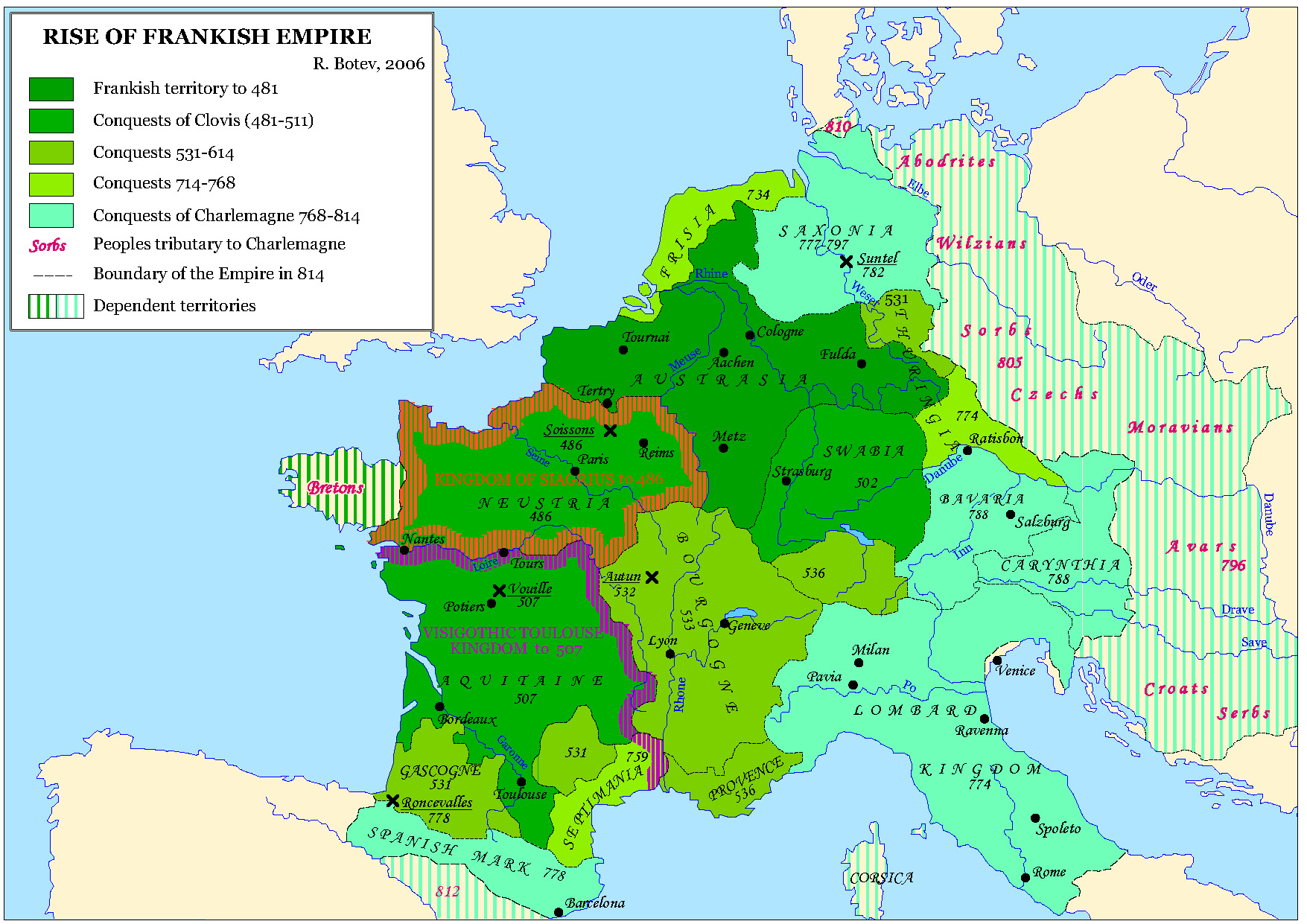|
Lantfrid
Lanfredus (Latinisation of names, Latinised from ''Lantfrid'' or ''Lanfred'') (died 730) was duke of Alamannia under Franks, Frankish sovereignty from 709 until his death. He was the son of duke Cotefredus. Lanfredus's brother was Theudebald (Alamannic ruler), Theudebald. Following Cotefredus's death in 709 and the accession of Lanfredus and his brother Theudebald, the Franks, Frankish ''Mayor of the Palace, maior domus'' Pepin of Herstal invaded Alamannia and fought against yet another duke, Willehari, whose territory was restricted to the Ortenau in western Alamannia. This campaign can be seen as an attempt by Pepin to impose royal authority on the duchy following the death of Cotefredus and also to assert his right to influence or even control the succession within the duchy. Pepin’s campaign against Willehari might therefore have taken place to assist Lanfredus and Theudebald in their claim to the duchy. However, both Lanfredus and Theudebald were hostile to Pepin’s succes ... [...More Info...] [...Related Items...] OR: [Wikipedia] [Google] [Baidu] |
Carolingian
The Carolingian dynasty ( ; known variously as the Carlovingians, Carolingus, Carolings, Karolinger or Karlings) was a Frankish noble family named after Charles Martel and his grandson Charlemagne, descendants of the Arnulfing and Pippinid clans of the 7th century AD. The dynasty consolidated its power in the 8th century, eventually making the offices of mayor of the palace and '' dux et princeps Francorum'' hereditary, and becoming the ''de facto'' rulers of the Franks as the real powers behind the Merovingian throne. In 751 the Merovingian dynasty which had ruled the Franks was overthrown with the consent of the Papacy and the aristocracy, and Pepin the Short, son of Martel, was crowned King of the Franks. The Carolingian dynasty reached its peak in 800 with the crowning of Charlemagne as the first Emperor of the Romans in the West in over three centuries. Nearly every monarch of France from Charlemagne's son Louis the Pious until the penultimate monarch of France Louis ... [...More Info...] [...Related Items...] OR: [Wikipedia] [Google] [Baidu] |
Theudebald (Alamannic Ruler)
Theudebald or Theutbald was the Duke of Alamannia from 730 until his deposition. He was a son of Gotfrid and brother and co-ruler with Lantfrid from 709. In 727, Theudebald expelled Pirmin, the founder of Reichenau Abbey, out of a hatred for Charles Martel (''ob odium Karoli''), whose influence in Alamannia he detested. During a military campaign in 730, Lantfrid was killed and Theudebald became sole duke. In 732, Theudebald was chased out of Alemannia by Charles Martel, but upon Charles' death in 741 he returned to claim his dukedom. In 742, Theudebald rebelled against the nominal authority of the Merovingian monarchy which was then being exercised by the two mayors of the palace Pepin the Short and Carloman; the Basques, Bavarii, and Saxons all revolted simultaneously. That same year Theudebald invaded the Duchy of Alsace, then ruled by Duke Liutfrid. The Alsatian duke was probably killed alongside his son fighting for the mayors. In 744, Pepin invaded the Swabian Jura ... [...More Info...] [...Related Items...] OR: [Wikipedia] [Google] [Baidu] |
Alamannia
Alamannia, or Alemania, was the kingdom established and inhabited by the Alemanni, a Germanic tribal confederation that had broken through the Roman '' limes'' in 213. The Alemanni expanded from the Main River basin during the 3rd century and raided Roman provinces and settled on the left bank of the Rhine River from the 4th century. Ruled by independent tribal kings during the 4th and the 5th centuries, Alamannia lost its independence in the late 5th century and became a duchy of the Frankish Empire in the 6th century. As the Holy Roman Empire started to form under King Conrad I of East Francia (reigning 911 to 918), the territory of Alamannia became the Duchy of Swabia in 915. Scribes often used the term '' Suebia'' interchangeably with ''Alamannia'' in the 10th to the 12th centuries. The territory of Alamannia as it existed from the 7th to 9th centuries centred on Lake Constance and included the High Rhine, the Black Forest and the Alsace on either side of the Upper Rhin ... [...More Info...] [...Related Items...] OR: [Wikipedia] [Google] [Baidu] |
Charles Martel
Charles Martel (; – 22 October 741), ''Martel'' being a sobriquet in Old French for "The Hammer", was a Franks, Frankish political and military leader who, as Duke and Prince of the Franks and Mayor of the Palace, was the de facto ruler of the Franks from 718 until his death. He was a son of the Frankish statesman Pepin of Herstal and a noblewoman named Alpaida. Charles successfully asserted his claims to power as successor to his father as the power behind the throne in Frankish politics. Continuing and building on his father's work, he restored centralized government in Francia and began the series of military campaigns that re-established the Franks as the undisputed masters of all Gaul. According to a near-contemporary source, the ''Liber Historiae Francorum'', Charles was "a warrior who was uncommonly ... effective in battle". Charles gained a victory against an Umayyad invasion of Aquitaine at the Battle of Tours, at a time when the Umayyad Caliphate controlled most of ... [...More Info...] [...Related Items...] OR: [Wikipedia] [Google] [Baidu] |
Willehari
Willehari or Willihari (, ''Wilharius'', ''Willeharius'', or ''Willicharius'') was an Alemannic duke (''dux'') in the Ortenau in the early eighth century. According to the ''Vita Sancti Desiderii'', Pepin of Heristal of the Franks, led two expeditions against Willehari in 709 and 712. It is unknown why Pepin intervened in Alemannia at this time, but it is likely that he was trying to affirm Frankish suzerainty by upholding the rights of succession of Lantfrid and Theudebald, the sons of the late duke Gotfrid, whom Willehari may have been elected to replace. It is possible that Alemannia was not united at this time and that several different regions were ruled separately by different families. Alsace, for one, was definitely ruled by another family, the Etichonids, and elsewhere it is likely that the Ahalolfings were in power. Sources *Geuenich, Dieter. ''Geschichte der Alemannen''. Kohlhammer Verlag W. Kohlhammer Verlag GmbH, or Kohlhammer Verlag, is a German publishing ho ... [...More Info...] [...Related Items...] OR: [Wikipedia] [Google] [Baidu] |
Lex Alamannorum
The Lex Alamannorum and Pactus Alamannorum were two early medieval law codes of the Alamanni. They were first edited in parts in 1530 by Johannes Sichard in Basel. Pactus Alamannorum The ''Pactus Alamannorum'' or ''Pactus legis Alamannorum'' is the older of the two codes, dating to the early 7th century. It is preserved in a single manuscript of the 9th to 10th century (Paris, Bibliothèque Nationale de France, MS Lat. 10753).For a catalogue description, see the entry in ''Bibliotheca Legum'': http://www.leges.uni-koeln.de/en/mss/codices/paris-bn-lat-10753/ Lex Alamannorum The ''Lex Alamannorum'' is preserved in some 50 manuscripts dating to between the 8th and 12th centuries. The text's first redaction is ascribed to the Alamannic duke Lantfrid in ca. 730. It is divided into clerical law, ducal law and popular law. Chapter 3.1 treats church asylum: no fugitive seeking refuge in a church should be removed by force, or be killed within the church. Instead, the pursuers should as ... [...More Info...] [...Related Items...] OR: [Wikipedia] [Google] [Baidu] |
730 Deaths
__NOTOC__ Year 730 ( DCCXXX) was a common year starting on Sunday of the Julian calendar. The denomination 730 for this year has been used since the early medieval period, when the Anno Domini calendar era became the prevalent method in Europe for naming years. Events By place Europe * King Liutprand contracts an alliance with Eutychius, exarch of Ravenna, and agrees to support him in his attack on Rome, while subjugating the independent southern Lombard duchies of Benevento and Spoleto. * Tiberius Petasius proclaims himself emperor in Tuscia. Eutychius defeats him with the support of Pope Gregory II, and Tiberius is killed in Monterano, with his head sent to the Byzantine emperor Leo III as a gift. * Charles Martel defeats the last independent dukedom of Alamannia, and incorporates it into the Frankish Empire. He also launches raids on the Saxons beyond the Rhine. Arabian Empire * September–October – Umayyad forces sack the Byzantine fortress of Chars ... [...More Info...] [...Related Items...] OR: [Wikipedia] [Google] [Baidu] |
8th-century Frankish Nobility
The 8th century is the period from 701 (represented by the Roman numerals DCCI) through 800 (DCCC) in accordance with the Julian Calendar. In the historiography of Europe the phrase the long 8th century is sometimes used to refer to the period of circa AD 660–820. The coast of North Africa and the Iberian Peninsula quickly came under Islamic Arab domination. The westward expansion of the Umayyad Empire was famously halted at the siege of Constantinople by the Byzantine Empire and the Battle of Tours by the Franks. The tide of Arab conquest came to an end in the middle of the 8th century.Roberts, J., '' History of the World'', Penguin, 1994. In Europe, late in the century, the Vikings, seafaring peoples from Scandinavia, begin raiding the coasts of Europe and the Mediterranean, and go on to found several important kingdoms. In Asia, the Pala Empire is founded in Bengal. The Tang dynasty reaches its pinnacle under Chinese Emperor Xuanzong. The Nara period begins in J ... [...More Info...] [...Related Items...] OR: [Wikipedia] [Google] [Baidu] |
Alemannic Warriors
Alemannic (''Alamannic'') or Alamanni may refer to: * Alemannic German, a group of Upper German dialects * Alemanni The Alemanni or Alamanni were a confederation of Germanic peoples, Germanic tribes * * * on the Upper Rhine River during the first millennium. First mentioned by Cassius Dio in the context of the campaign of Roman emperor Caracalla of 213 CE ..., a confederation of Suebian Germanic tribes in the Roman period * Alamanni (surname) See also * Alemannia (other) * Alemannic separatism * Allemand (other) {{disambig ... [...More Info...] [...Related Items...] OR: [Wikipedia] [Google] [Baidu] |
Kohlhammer Verlag
W. Kohlhammer Verlag GmbH, or Kohlhammer Verlag, is a German publishing house headquartered in Stuttgart. History Kohlhammer Verlag was founded in Stuttgart on 30 April 1866 by . Kohlhammer had taken over the businesses of his late father-in-law, a 120-year-old printer and a profitable . The printing business, operating out of the back of a commercial building at 14 Urbanstrasse, became W. Kohlhammer Verlag and was funded by proceeds from the bathhouse until it was closed in 1890. Kohlhammer purchased the ''Deutsche Feuerwehrzeitung'' in 1882 and printed that publication until 1923. In 1872 Kohlhammer started a weekly newspaper, the ''Neue Deutsche Familienblatt'' that by 1914 had a circulation of 185,000. Contemporary Employees of Kohlhammer joined those of other Stuttgart-based companies in early 2016 to petition the mayor to abate traffic congestion hindering their operations inside the city. In 2017, Kohlhammer Verlag employed about 400 people in Stuttgart, Würzburg and A ... [...More Info...] [...Related Items...] OR: [Wikipedia] [Google] [Baidu] |



